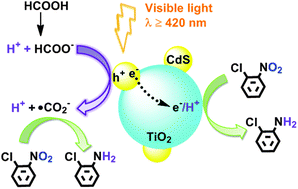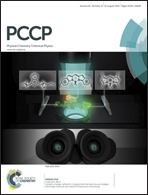Photocatalytic reduction of o-chloronitrobenzene under visible light irradiation over CdS quantum dot sensitized TiO2†
Abstract
The photocatalytic activity of CdS/P25 hybrid catalysts was studied under visible-light irradiation. The CdS quantum dots sensitized P25 (CdS QDs-P25) showed extremely enhanced activity in the reduction of o-chloronitrobenzene (o-CNB) by comparing to CdS–P25 prepared by the direct deposition–precipitation method in the presence of HCOOH. The synergistic effects between CdS QDs and P25 were beneficial for the separation of photogenerated carriers in space and thus the combination of photoelectrons and holes was prevented, and the CdS QDs could provide more photocharges than CdS due to the particle size effect. Furthermore, the process of photocatalytic reduction in the present system was investigated, under visible-light irradiation, the photogenerated electrons transferred from the valence band (VB) to the conduction band (CB) of CdS QDs, and injected into the CB of inactivated P25. Meanwhile, the holes generated in the VB of CdS QDs could oxidize HCOO− to give ˙CO2− and H+. Then, o-CNB was reduced to o-chloroaniline (o-CAN) by the couple of e− and ˙CO2− with H+. It is a significant method and a green process for hydrogenation of nitro compounds, which may have great potential applications in the reduction of various organic chemicals.


 Please wait while we load your content...
Please wait while we load your content...